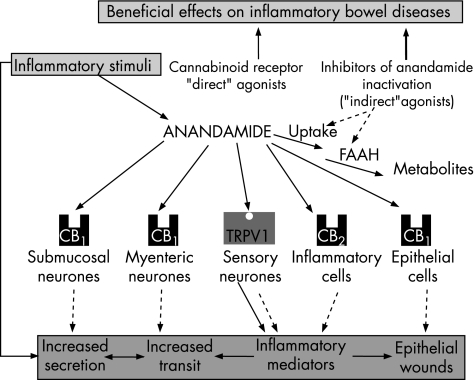Figure 1 Endocannabinoid control of intestinal inflammation. Inflammatory stimuli upregulate anandamide levels and, in some cases, its major molecular targets, the cannabinoid CB1 and CB2 receptors. Depending on their cellular localisation, activation of these receptors by anandamide may cause various effects, in most cases leading to reduction of the consequences of inflammation. Therefore, blockers of anandamide inactivation (for example, inhibitors of anandamide cellular reuptake or intracellular hydrolysis by fatty acid amide hydrolase (FAAH)), by elevating anandamide levels further, and thus “indirectly” activating anandamide targets only “where and when” there is enhanced anandamide turnover, might also produce therapeutic effects in intestinal inflammatory conditions, possibly more efficaciously and safely than “direct” cannabinoid receptor agonists. Anandamide may also activate vanilloid TRPV1 receptors (mostly located on primary afferent neurones), resulting in pro‐ (following activation) or anti‐ (after desensitisation) inflammatory effects. Continuous arrows denote stimulation, induction, or processing; broken arrows denote inhibition. TRPV1, transient receptor potential vanilloid type 1 receptor

An official website of the United States government
Here's how you know
Official websites use .gov
A
.gov website belongs to an official
government organization in the United States.
Secure .gov websites use HTTPS
A lock (
) or https:// means you've safely
connected to the .gov website. Share sensitive
information only on official, secure websites.
